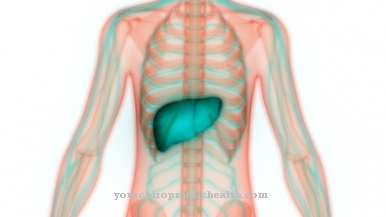In the Abdominal breathing, also Abdominal breathing called, breathing is largely determined by a contraction of the diaphragm. Abdominal breathing ventilates more of the lungs than chest breathing.
What is abdominal breathing?

The diaphragm, the most important inhalation muscle, is used in abdominal breathing. The diaphragm is a dome-shaped muscle-tendon plate that separates the abdominal cavity from the thoracic cavity. On the side of the chest cavity, the diaphragm borders on the lungs and the median space.
With abdominal breathing, the diaphragm contracts when you inhale. This means that the muscle-tendon plate contracts and moves downwards towards the abdominal organs. The shape of the diaphragm changes from the dome to the cone. The abdomen arches outwards and the chest expands by lifting the lower ribs slightly.
The enlargement of the chest creates a negative pressure in the so-called pleural cavity. The pleural cavity is a body cavity that lies between the two sheets of the pleura. The pleura is also known as the pleura. The pleural fluid is located between the two pleural leaves. It forms a fine liquid film on the leaves. Through this film, the two sheets adhere to each other. This can be compared with two panes of glass: If they lie on top of one another, moistened with a little water, these panes of glass can be shifted on top of one another, but not separated from one another.
One pleural leaf rests against the chest, the other rests on the lungs. The expansion of the thorax also pulls the outer pleural leaf with it. Because of the attachment, the inner pleural leaf follows and the lungs expand as does the chest. The air pressure outside the lungs is greater than the air pressure inside the lungs due to the resulting negative pressure. As a result, air flows into the lungs through the trachea.
The breathing process is supported by the intercostal muscles. When you exhale, the diaphragm muscles relax again. The lungs contract and the diaphragm also returns to its original dome shape. The air flows out.
In contrast to inhalation, exhalation is a passive process. This means that no muscles are actively involved in healthy people when they exhale.
Function & task
Humans inhale and exhale about ten to fifteen times a minute. The breathing rate is increased during exertion. In this way, ten thousand liters of air pass through the airways every day. In the lungs, the red blood cells absorb the inhaled oxygen and give off carbon dioxide.
Oxygen is required for the production of energy in the body cells. Without oxygen, body cells die within a very short time. Sufficient air must be able to get into the lungs for an optimal oxygen supply. This only works if the entire lungs are involved in the breathing process.
The tidal volume with abdominal breathing is higher than that with chest breathing. The tidal volume is the volume that is inhaled and exhaled with each breath. The product of the tidal volume and the number of breaths per minute is called the tidal volume. The maximum breathing time volume can only be achieved with abdominal breathing.
When breathing through the chest, air is exchanged only in the upper parts of the lungs. The respiratory volume can therefore not be exhausted. The result is a lack of oxygen. This manifests itself, for example, in difficulty concentrating and tiredness.
The lowering of the diaphragm when you inhale pushes the digestive organs downwards. The bulging of the abdomen ensures that there is no increased pressure in the abdomen. Nevertheless, the abdominal organs have to move closer together, the diaphragm pressing on the organs from above. Abdominal breathing has a kind of massage effect on the abdominal organs. This aids digestion.In addition, abdominal breathing also promotes the return flow of venous blood from the circulatory system into the heart, because the pressure gradient in the chest creates a suction effect in the inferior vena cava.
Abdominal breathing has a generally relaxing effect on the body. The blood pressure is lowered. Therefore, conscious abdominal breathing is recommended for patients with panic disorders. With abdominal breathing, the amount of air can also be regulated much better. Singers, brass musicians and martial artists make use of this fact as a breathing aid.
You can find your medication here
➔ Medication for shortness of breath and lung problemsIllnesses & ailments
Abdominal breathing is not always possible, especially with diseases and impairments of the diaphragm. If the diaphragm bulges towards the chest, it is called an elevated diaphragm. On the one hand, this can be caused by diseases of the abdominal organs, such as liver or spleen swellings or lung malformations. Pregnancy, large tumors in the abdomen and even severe flatulence can push the diaphragm upwards. As a result, the diaphragm can no longer lower itself and the chest and lungs can only expand to a limited extent. The result is a so-called restrictive ventilation disorder of the lungs, which leads to breathing problems.
Adhesion of the pleura or pulmonary fibrosis can also make abdominal breathing difficult. The same applies to a restricted mobility of the chest. In the case of scoliosis and a funnel chest, for example, abdominal breathing is not possible or only with great difficulty.
Abdominal breathing is impaired even with paralysis of the diaphragm. Diaphragmatic paralysis is usually caused by paralysis of the phrenic nerve. The diaphragm slackens. As a result, the abdominal organs are no longer pressed towards the abdomen, but rather press towards the chest and hinder breathing there. Diaphragmatic paralysis can be caused by surgery, pneumonia, or liver disease.



























